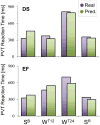Sleep reverts changes in human gray and white matter caused by wake-dependent training
- PMID: 26812659
- PMCID: PMC4803519
- DOI: 10.1016/j.neuroimage.2016.01.020
Sleep reverts changes in human gray and white matter caused by wake-dependent training
Abstract
Learning leads to rapid microstructural changes in gray (GM) and white (WM) matter. Do these changes continue to accumulate if task training continues, and can they be reverted by sleep? We addressed these questions by combining structural and diffusion weighted MRI and high-density EEG in 16 subjects studied during the physiological sleep/wake cycle, after 12 h and 24 h of intense practice in two different tasks, and after post-training sleep. Compared to baseline wake, 12 h of training led to a decline in cortical mean diffusivity. The decrease became even more significant after 24 h of task practice combined with sleep deprivation. Prolonged practice also resulted in decreased ventricular volume and increased GM and WM subcortical volumes. All changes reverted after recovery sleep. Moreover, these structural alterations predicted cognitive performance at the individual level, suggesting that sleep's ability to counteract performance deficits is linked to its effects on the brain microstructure. The cellular mechanisms that account for the structural effects of sleep are unknown, but they may be linked to its role in promoting the production of cerebrospinal fluid and the decrease in synapse size and strength, as well as to its recently discovered ability to enhance the extracellular space and the clearance of brain metabolites.
Keywords: DWI; Extracellular space; MRI; Mean diffusivity; Sleep deprivation.
Copyright © 2016 Elsevier Inc. All rights reserved.
Conflict of interest statement
Conflicts of interest. G. Tononi is involved in a research study in humans supported by Philips Respironics. This study is not related to the work presented in the current manuscript. R. Benca has served as a consultant to Merck and Jazz, and receives research funding from Merck. A. Alexander is part owner of inseRT MRI, Inc. This company is not related to the work and did not sponsor this research. The other authors have indicated no financial conflicts of interest.
Figures





References
-
- Alexander AL, Hasan KM, Lazar M, Tsuruda JS, Parker DL. Analysis of partial volume effects in diffusion-tensor MRI. Magn Reson Med. 2001;45:770–780. - PubMed
-
- Anderson BJ, Li X, Alcantara AA, Isaacs KR, Black JE, Greenough WT. Glial hypertrophy is associated with synaptogenesis following motor-skill learning, but not with angiogenesis following exercise. Glia. 1994;11:73–80. - PubMed
-
- Assaf Y, Pasternak O. Diffusion tensor imaging (DTI)-based white matter mapping in brain research: a review. J Mol Neurosci. 2008;34:51–61. - PubMed
Publication types
MeSH terms
Grants and funding
LinkOut - more resources
Full Text Sources
Other Literature Sources

